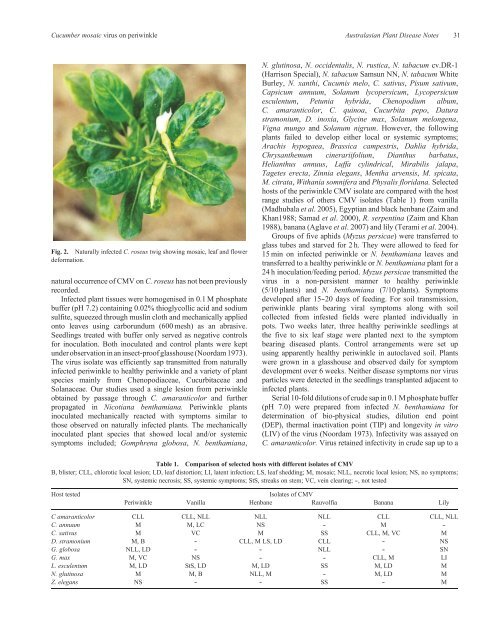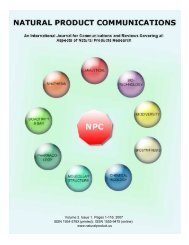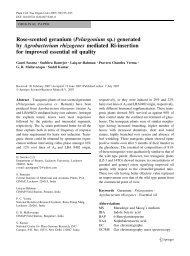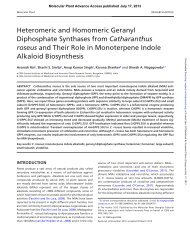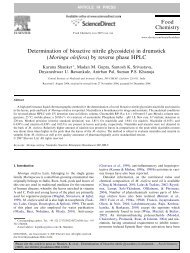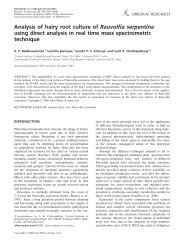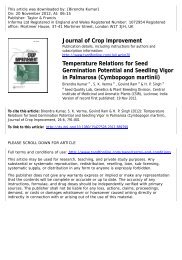Natural infection of periwinkle (Catharanthus roseus ... - CIMAP Staff
Natural infection of periwinkle (Catharanthus roseus ... - CIMAP Staff
Natural infection of periwinkle (Catharanthus roseus ... - CIMAP Staff
Create successful ePaper yourself
Turn your PDF publications into a flip-book with our unique Google optimized e-Paper software.
Cucumber mosaic virus on <strong>periwinkle</strong> Australasian Plant Disease Notes 31Fig. 2. <strong>Natural</strong>ly infected C. <strong>roseus</strong> twig showing mosaic, leaf and flowerdeformation.natural occurrence <strong>of</strong> CMV on C. <strong>roseus</strong> has not been previouslyrecorded.Infected plant tissues were homogenised in 0.1 M phosphatebuffer (pH 7.2) containing 0.02% thioglycollic acid and sodiumsulfite, squeezed through muslin cloth and mechanically appliedonto leaves using carborundum (600 mesh) as an abrasive.Seedlings treated with buffer only served as negative controlsfor inoculation. Both inoculated and control plants were keptunder observation in an insect-pro<strong>of</strong> glasshouse (Noordam 1973).The virus isolate was efficiently sap transmitted from naturallyinfected <strong>periwinkle</strong> to healthy <strong>periwinkle</strong> and a variety <strong>of</strong> plantspecies mainly from Chenopodiaceae, Cucurbitaceae andSolanaceae. Our studies used a single lesion from <strong>periwinkle</strong>obtained by passage through C. amaranticolor and furtherpropagated in Nicotiana benthamiana. Periwinkle plantsinoculated mechanically reacted with symptoms similar tothose observed on naturally infected plants. The mechanicallyinoculated plant species that showed local and/or systemicsymptoms included; Gomphrena globosa, N. benthamiana,N. glutinosa, N. occidentalis, N. rustica, N. tabacum cv.DR-1(Harrison Special), N. tabacum Samsun NN, N. tabacum WhiteBurley, N. xanthi, Cucumis melo, C. sativus, Pisum sativum,Capsicum annuum, Solanum lycopersicum, Lycopersicumesculentum, Petunia hybrida, Chenopodium album,C. amaranticolor, C. quinoa, Cucurbita pepo, Daturastramonium, D. inoxia, Glycine max, Solanum melongena,Vigna mungo and Solanum nigrum. However, the followingplants failed to develop either local or systemic symptoms;Arachis hypogaea, Brassica campestris, Dahlia hybrida,Chrysanthemum cinerariifolium, Dianthus barbatus,Helianthus annuus, Luffa cylindrical, Mirabilis jalapa,Tagetes erecta, Zinnia elegans, Mentha arvensis, M. spicata,M. citrata, Withania somnifera and Physalis floridana. Selectedhosts <strong>of</strong> the <strong>periwinkle</strong> CMV isolate are compared with the hostrange studies <strong>of</strong> others CMV isolates (Table 1) from vanilla(Madhubala et al. 2005), Egyptian and black henbane (Zaim andKhan1988; Samad et al. 2000), R. serpentina (Zaim and Khan1988), banana (Aglave et al. 2007) and lily (Terami et al. 2004).Groups <strong>of</strong> five aphids (Myzus persicae) were transferred toglass tubes and starved for 2 h. They were allowed to feed for15 min on infected <strong>periwinkle</strong> or N. benthamiana leaves andtransferred to a healthy <strong>periwinkle</strong> or N. benthamiana plant for a24 h inoculation/feeding period. Myzus persicae transmitted thevirus in a non-persistent manner to healthy <strong>periwinkle</strong>(5/10 plants) and N. benthamiana (7/10 plants). Symptomsdeveloped after 15--20 days <strong>of</strong> feeding. For soil transmission,<strong>periwinkle</strong> plants bearing viral symptoms along with soilcollected from infested fields were planted individually inpots. Two weeks later, three healthy <strong>periwinkle</strong> seedlings atthe five to six leaf stage were planted next to the symptombearing diseased plants. Control arrangements were set upusing apparently healthy <strong>periwinkle</strong> in autoclaved soil. Plantswere grown in a glasshouse and observed daily for symptomdevelopment over 6 weeks. Neither disease symptoms nor virusparticles were detected in the seedlings transplanted adjacent toinfected plants.Serial 10-fold dilutions <strong>of</strong> crude sap in 0.1 M phosphate buffer(pH 7.0) were prepared from infected N. benthamiana fordetermination <strong>of</strong> bio-physical studies, dilution end point(DEP), thermal inactivation point (TIP) and longevity in vitro(LIV) <strong>of</strong> the virus (Noordam 1973). Infectivity was assayed onC. amaranticolor. Virus retained infectivity in crude sap up to aTable 1. Comparison <strong>of</strong> selected hosts with different isolates <strong>of</strong> CMVB, blister; CLL, chlorotic local lesion; LD, leaf distortion; LI, latent <strong>infection</strong>; LS, leaf shedding; M, mosaic; NLL, necrotic local lesion; NS, no symptoms;SN, systemic necrosis; SS, systemic symptoms; StS, streaks on stem; VC, vein clearing; --, not testedHost testedIsolates <strong>of</strong> CMVPeriwinkle Vanilla Henbane Rauvolfia Banana LilyC amaranticolor CLL CLL, NLL NLL NLL CLL CLL, NLLC. annuum M M, LC NS -- M --C. sativus M VC M SS CLL, M, VC MD. stramonium M, B -- CLL, M LS, LD CLL -- NSG. globosa NLL, LD -- -- NLL -- SNG. max M, VC NS -- -- CLL, M LIL. esculentum M, LD StS, LD M, LD SS M, LD MN. glutinosa M M, B NLL, M -- M, LD MZ. elegans NS -- -- SS -- M


